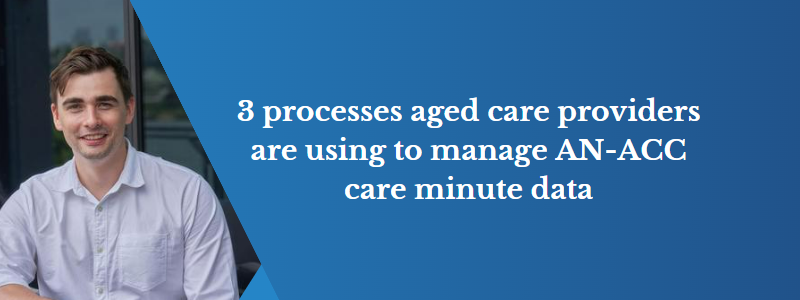Managing AN-ACC Care Minute Data
March 10, 2023 | AN-ACC

Under AN-ACC, care minute data is crucial for all admission and reclassification decisions because it is required to determine if resident movements and reclassifications will be truly beneficial for the site, or if they will push care minute targets beyond the current workforce capacity.
Care minutes become more complex as we start to dive into the details. Some of the questions we need to ask include:
- Which hybrid roles will we include in our care minutes & what weightings will we apply?
- How do our planned care minutes vary from delivered care minutes on a fortnightly basis?
- Given our current workforce, what is our optimal occupancy & case mix target?
- What star rating are we aiming for?
- Is pushing for a higher ADS beneficial if we then spend it directly on agency staff to meet our new care minute target?
- Where am I going to find more RNs?
While there are many aspects to consider when managing care minutes, arguably the most important is having accurate and accessible data. Through our work with providers, we have observed a lack of care minute data availability. Even when the reporting of care minutes is in place, there is a disconnect between the reporting that is visible at the management level and the individual resident detail required to make decisions. Also, the timeliness and coordination of this information between operational teams is lacking.
This leads to AN-ACC coordinators and clinical management requesting upward resident reclassifications to increase AN-ACC funding independently of admissions and rostering and therefore without having visibility over the impact that this will have on care minute targets and star ratings. This impact will increase after 1 October 2023 when care minute compliance becomes mandatory.
To manage this flow of information, we have seen providers implement a variety of changes over the last few months to improve the communication and flow of data between the admissions coordinator, roster coordinator & clinical managers.
Three of these changes are:
- improvement of their systems such as rostering platforms that provide costed care minute data in real time and track against targets (like Mirus Works!) and a funding application to manage AN-ACC transaction level data (like Mirus Metrics),
- monthly meetings with the relevant stakeholders to establish an operating rhythm to share knowledge and bed down new processes,
- a simple fortnightly email between the functions to increase transparency of information.
Rostering Platforms
The connection of funding and care minutes under AN-ACC has changed the playing field for roster platforms. Modules of finance systems, basic time and attendance and other unsophisticated rostering support technologies may not be enough for the rapidly changing requirements of Australian Aged Care. Many providers have opted to invest in updating to a more modern, comprehensive rostering platform (Mirus Works!) which provides real-time costed care minute reporting and includes the interpretation of a care minute policy. This allows the rostering & clinical coordinators to access historical, current and planned care minutes within a few simple clicks, and removes the significant administrative burden of manually calculating this information. This supports the flow of information between the admissions, rostering & clinical areas of the business by providing direct access to the dashboards in the rostering platform, so that the data is always up-to-date, accurate & available.
Monthly Meeting
Some providers have established a fortnightly or monthly meeting between the admissions, rostering & clinical coordinators to promote the flow of information between these decision-making areas of the business. The purpose of this meeting is two fold:
- Driving collaboration – Breaking down the silos between these functions that have traditionally not needed a great deal of interaction. These functions ran independently with their own goals but now the decision making in each function will have direct consequences on all the others.
- Establishing an operating rhythm – A regular meeting, tied to roster periods and other regular events (eg QFR reporting) will help establish the information flows and decision making steps required to manage and control AN-ACC. In time, the information and systems may not require so much meeting time but it is advisable in the short term to establish the process.
A typical agenda for these meetings will include how many care minutes were delivered per bed per day over the last month, highlight any changes to planned care minutes through new hires or resignations, how many potential new residents are on the waiting list, and how many residents have been identified for potential AN-ACC uplift or downward reclassification. We have built Mirus Metrics to support this process via the scenario planning tool, which allows providers to preview the impact of new admissions & reclassifications on revenue and care minute targets before committing to these decisions.
Fortnightly Email
We have also seen some smaller providers establish a simpler process whereby the rostering team sends a fortnightly email to the clinical & admission teams with a retrospective look at how many care minutes were delivered (actual), and a summary of planned care minutes for the following fortnight. While this method is limited in its flow of communication between departments, having a view of this data is imperative for the admissions and clinical team to ensure that any new admissions or reclassification decisions can be supported by the existing workforce.
Care minute targets become mandatory in October 2023, and are already impacting providers through star ratings. How are you managing the crucial communication between admissions, rostering & clinical decision makers?
Find out more about how our AN-ACC Optimisation program can support you to validate the accuracy of AN-ACC subsidies and train your team on the AN-ACC assessment tools to embed a sustainable AN-ACC identification process within your organisation.
If you’re looking to advance your team’s understanding of the AN-ACC assessments and how to use them, then our AN-ACC Advance Module 2 course will give you good grounding in this from a theoretical perspective.


